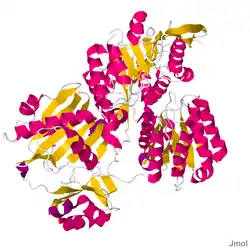ATP-Citrat-Lyase
ATP-Citrat-Lyase (auch: ATP-Citrat-Synthase) ist das Enzym, das im Zytosol eukaryotischer Zellen eine Acetylgruppe von Citrat auf Coenzym A überträgt, woraus unter anderem Acetyl-CoA resultiert. Dies ist der zweite Reaktionsschritt im Citrat-Shuttle, welches notwendig ist, um das bei der oxidativen Decarboxylierung produzierte Acetyl-CoA aus den Mitochondrien herauszubefördern. Diese Prozesse sind Teil des Energiestoffwechsels in allen Eukaryoten.[1]
| ATP-Citrat-Lyase | ||
|---|---|---|
 | ||
| Eigenschaften des menschlichen Proteins | ||
| Masse/Länge Primärstruktur | 1101 Aminosäuren | |
| Sekundär- bis Quartärstruktur | Homotetramer | |
| Kofaktor | Magnesium | |
| Bezeichner | ||
| Gen-Name | ACLY | |
| Externe IDs | ||
| Enzymklassifikation | ||
| EC, Kategorie | 2.3.3.8, Transferase | |
| Reaktionsart | Übertragung einer Acetylgruppe | |
| Substrat | ATP + Citrat + CoA | |
| Produkte | ADP + Oxalacetat + Acetyl-CoA + Pi | |
| Vorkommen | ||
| Homologie-Familie | ACLY | |
| Übergeordnetes Taxon | Eukaryoten | |
Das erzeugte Acetyl-CoA ist Ausgangsstoff für die im Zytosol stattfindende Lipogenese.
Hypocitraturie ist eine Ursache für Nierensteine und kann eine überhöhte Aktivität der ATP-Citrat-Lyase in Urin-Leukozyten als Ursache haben, wie in einer thailändischen Studie festgestellt. Nahrungsumstellung oder Kaliumcitrat-Supplementation sind mögliche Therapien.[2] ATP-Citrat-Lyase ist ein mögliches Target für die Bekämpfung von Krebs.[3][4] Ein Inhibitor der ATP-Citrat-Lyase, Bempedoinsäure, hat in einer Phase 3-Studie den LDL-Spiegel in einer Kombinationstherapie mit Statinen weiter gesenkt als Statine allein.[5] Die Marktzulassung unter dem Namen Nilemdo erfolgte in der EU im April 2020.
Katalysierte Reaktion
 + CoA-SH + ATP ⇒
+ CoA-SH + ATP ⇒
⇒![]() +
+ ![]() + ADP + Pi
+ ADP + Pi
Ein Acetylrest wird unter ATP-Verbrauch von Citrat auf CoA übertragen: es entsteht Oxalacetat und Acetyl-CoA.
Weblinks
- Gopinathrao/reactome.org: Generation of Cytoplasmic Acetyl CoA from Citrate
Einzelnachweise
- UniProt P53396
- Tosukhowong P, Borvonpadungkitti S, Prasongwatana V, et al: Urinary citrate excretion in patients with renal stone: roles of leucocyte ATP citrate lyase activity and potassium salts therapy. In: Clin. Chim. Acta. 325, Nr. 1–2, November 2002, S. 71–8. PMID 12367768.
- Hatzivassiliou G, Zhao F, Bauer DE, et al: ATP citrate lyase inhibition can suppress tumor cell growth. In: Cancer Cell. 8, Nr. 4, Oktober 2005, S. 311–21. doi:10.1016/j.ccr.2005.09.008. PMID 16226706.
- Migita T, Narita T, Nomura K, et al: ATP citrate lyase: activation and therapeutic implications in non-small cell lung cancer. In: Cancer Res.. 68, Nr. 20, Oktober 2008, S. 8547–54. doi:10.1158/0008-5472.CAN-08-1235. PMID 18922930.
- Ray KK, Bays HE, Catapano AL, et al: Safety and efficacy of bempedoic acid to reduce LEL cholesterol. In: N. Engl. J. Med.. 380, Nr. 11, März 2019, S. 1022–1032. doi:10.1056/NEJMoa1803917.